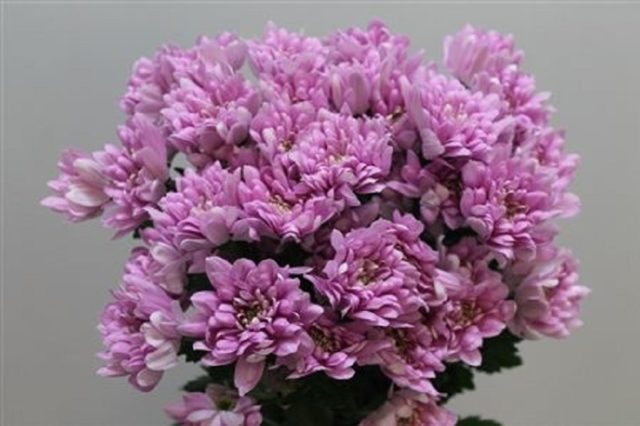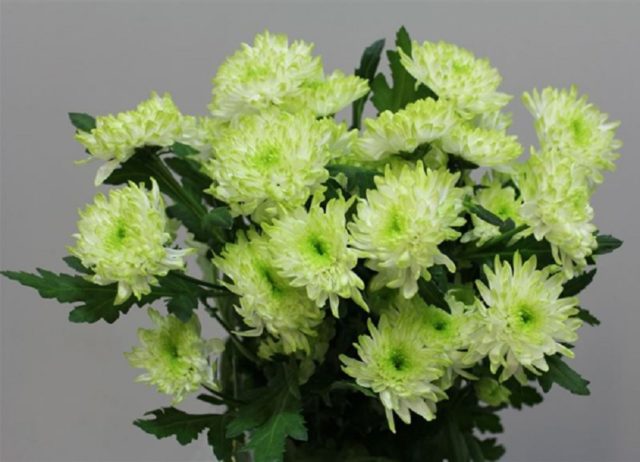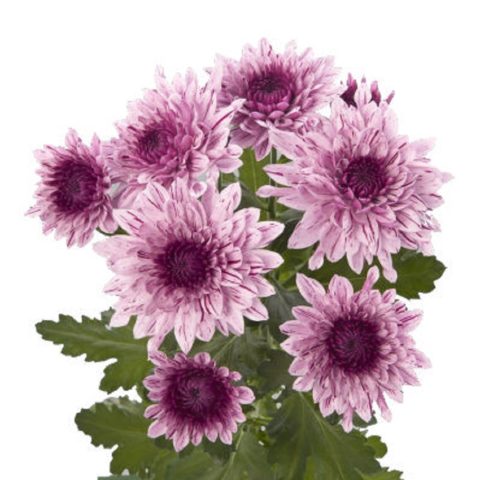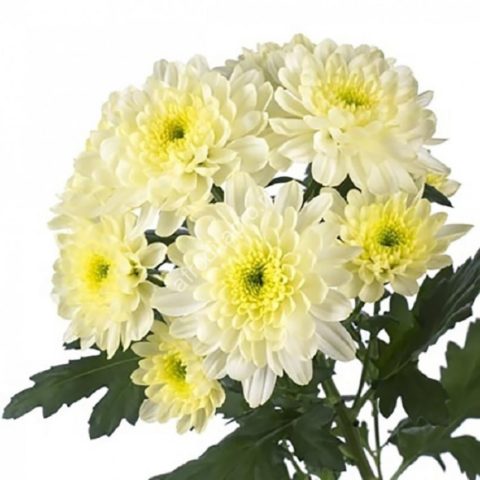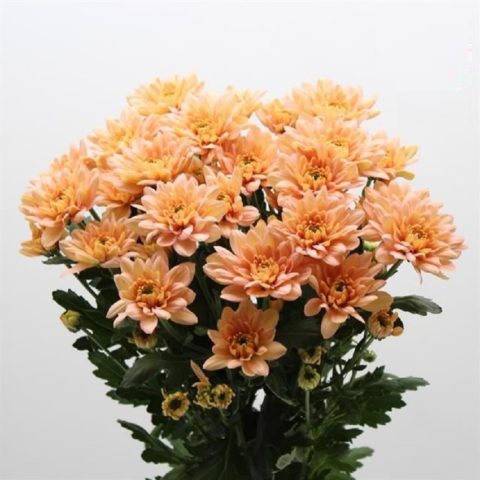Content
Chrysanthemum Baltika leaves no one indifferent. This is a species of spray chrysanthemums of the Astrov family. Flower lovers grow it in the garden or on the windowsill. In any case, this amazingly beautiful plant looks luxurious. Photo of chrysanthemum Baltika:
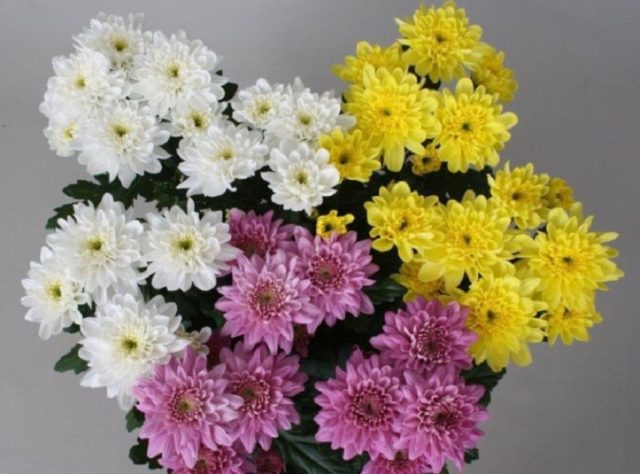
It is recommended to make bouquets from different types of Baltic
Features of growing bush chrysanthemum Baltika
Growing a variety is easy. It also reproduces well. Baltika has one nuance - it loses its decorative effect when grown in a permanent place for more than 5 years. This must be taken into account when planning a site or flower bed. The plant grows well on the street and on the windowsill. The difference in external conditions affects the size of the flower. The street chrysanthemum Baltika forms buds of 10-25 cm, and the indoor chrysanthemum is about 12 cm. It is also grown indoors as an annual. The rest of the parameters do not differ significantly:
- The plant is bushy, the height in an adult state is about 90 cm outdoors and 30 cm indoors.
- Flowering period begins in September. This is an early flowering variety of bush chrysanthemum.
- Branched and thickened roots. They are located close enough to the surface of the earth.
- The inflorescences resemble a ball in shape, the flowers are large, with reed petals. The rosettes are tight, the aroma is very delicate with honey notes. The buds have a different color than the Baltika variety and attracts gardeners. Refers to large-flowered chrysanthemums.
- The leaves are dark green, divided, feathery. The upper part of the leaf plate is slightly fleecy, and the lower one is completely smooth. Serrated edges.
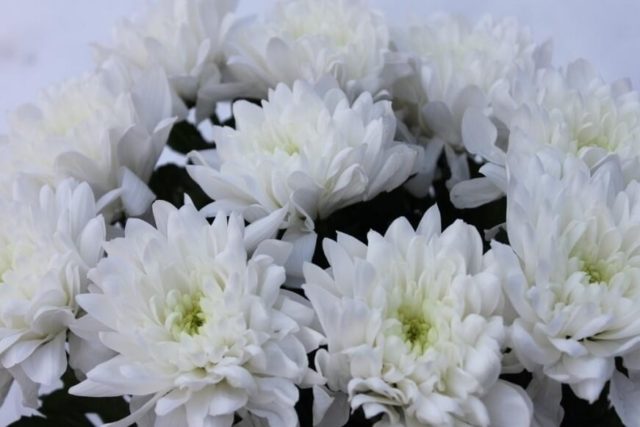
Some parameters may vary depending on the region of cultivation.
The variety is very fond of light, but requires protection from the midday heat. It has many advantages over other varieties of bush chrysanthemums:
- frost resistance and the ability to bloom before frost;
- endurance and unpretentiousness;
- great variability in color;
- stability after cutting;
- the possibility of growing on the street and in the room.
Gardeners argue that the Baltic is free from flaws. Therefore, the variety is very popular.
Types of colors of chrysanthemum Baltika
The different color of the buds of the bush variety allows you to choose a plant with the desired characteristic. The cultivation algorithm is identical for any species. Therefore, several varieties of the Baltic can be planted at the same time.
Among the most popular are:
- White Baltic or White (Baltica White). Snow-white large inflorescences, unpretentiousness to growing conditions, suitability for cutting are important parameters of the variety. The height of the Baltic White chrysanthemum bush is from 60 to 70 cm. In the middle of the petals there are greenish blotches. Chrysanthemum Baltika white is considered a royal species.
White chrysanthemum is best used as the dominant flower in a bouquet.
- Pink Baltika or Pink (Baltica Рink). The colors of the petals are pink and mint tones, the height of the bush is 85 cm. The flowers are very delicate, they look great when cut. Chrysanthemum Baltika Pink goes well with chrysanthemums of other tones.
Pink inflorescences add tenderness to any composition, this must be taken into account when planting a variety
- Yellow Baltic or Yellow (Baltica Yellow). The color of the globular inflorescences is bright yellow. Sometimes lemon yellow. Chrysanthemum Baltica Yellow is considered the largest and most popular variety.The height of an adult stem is about 65 cm.
Fire colors are preferable to plant near conifers
- Lemon Baltika or Lime (Baltica Lime). The very unusual color of the flowers immediately attracts attention. The petals are painted white-light green with lemon-green edges. Additional charm to the chrysanthemum is given by the large size of the globular inflorescences.
A variety of this color looks good in combination with other perennials of saturated colors.
- Baltic VIP. This is a hybrid characterized by the number of inflorescences. Much more of them are formed on one bush than in a regular variety. The color of the petals is extraordinary - light pink, with streaks of lilac or purple flowers.
The unique shade of the hybrid is more advisable to use in a cut than in a regular flower bed.
- Lilac Baltic or Lilac (Baltic Lilac). The petals of this variety are very wide, and the diameter of the flower is medium. However, the delicate lilac color gives Lilak chrysanthemum a unique charm.
The width of the chrysanthemum petal allows you to combine the look with roses
- Baltic Purple. This is a chrysanthemum with a richer purple petal color. The buds are large, the inflorescences are spherical. Long standing in the cut.
Chrysanthemum of saturated color looks advantageous even without framing with other varieties
- Baltic Crem. Chrysanthemum Baltika has cream, the color of the petals is closer to yellow. It personifies soft rays of the sun, it cheers up well. Very suitable for making bright bouquets of chrysanthemums alone or in combination with other plants. Chrysanthemum Baltika with yellow flowers can be mixed with greens or roses.
Another variety, which, due to its color, belongs to the leaders among the Baltic species
- Salmon Baltica (Вaltica Salmon). The Dutch variety is a novelty in the flower market. We first learned about it in Moscow at the Flowers Expo 2017. Up to 10-12 flowers are formed on one stem of chrysanthemum Baltika Salmon. The color of the petals is peach, the foliage is dark green. Together they create an amazing duet, all this is complemented by a delicate aroma.
One bush of the variety is enough to create a full-fledged bouquet.
Sometimes gardeners add dyes when watering in order to get an even more unusual color of the petals of the Baltika chrysanthemum.
Landing
Before planting bush chrysanthemums, you need to familiarize yourself with the basic rules of the procedure. Gardeners should meet the optimal time frame, choose the right place, and find the right soil. Attention must be paid to:
- Landing time. It is preferable to plant the Baltic at the beginning of the season - in the spring. In this case, the heating of the soil at a depth of 15-20 cm should be at least 12-14 ° C. On the territory of the southern regions, chrysanthemum bush Baltica is planted from the beginning of April. Gardeners of the Moscow region, Siberia and the Central regions are shifting the date to the beginning of June. Autumn planting is carried out throughout September, until the temperature drops to + 12 ° C. If in the fall for some reason the deadline had to be missed, then the plant can be cut into a pot. In the spring, transplant into open ground.Important! The term of spring planting depends on the end time of return frosts.
- A place for the chrysanthemum. Baltika prefers a well-heated space, protected from wind and drafts. Penumbra will not work. With a lack of lighting, the flowers lose their decorative effect and become small.
- Soil. Chrysanthemum bush grows well on fertile, slightly acidic or neutral soil. Ideally, if there is light sandy loam on the site, which needs to be filled with humus or vermicompost. You do not need to be zealous so as not to get a lush green bush without inflorescences as a result.
- The occurrence of groundwater. Baltika does not tolerate stagnant water. This leads to rotting of the root system. Chrysanthemum should only be planted in drained flower beds. You can equip a body bed, add river coarse sand.
The planting algorithm for bush Baltica from other varieties is almost the same. The gardener just needs to follow a series of steps in a specific order.The main thing is not to plant the variety after other Aster or Solanaceae. The Baltic can be returned to its original place not earlier than in 2-3 years.
Process steps:
- Preliminary preparation of the site in the fall. It includes digging soil, fertilizing. For 1 sq. m of area, it is enough to add 30 g of potassium salt, 50 g of superphosphate. If necessary, take measures to structure and reduce acidity. In the spring, re-dig the garden bed.
- Digging planting holes. The volume of each depends on the size of the seedling. The optimum depth is 25-40 cm. It is convenient to dig a trench and evenly place the Baltic seedlings in it.
- Planting chrysanthemums. The day must be overcast. Place the seedling in the hole, sprinkle the roots with earth. The root collar should be buried no more than 2 cm. If the chrysanthemum has wintered in a pot, then the base of the stem should be left at the same height.
- Watering and mulching. You can add 1 g of Kornevin to the water for each liter and pour the chrysanthemums. This will allow the plant to form a root system faster. The first days the near-stem circle of the seedling must be covered with a non-woven material to protect it from the sun. Peg and tie up the stems.
- Topping. It should be done immediately after planting bush chrysanthemum, and then repeated after 20 days.
For group planting, a staggered arrangement of the bushes is recommended.

It is necessary to plant chrysanthemum seedlings, strictly adhering to the scheme
Chrysanthemum Baltika care
The variety does not require any special techniques, a standard set is enough for it:
- watering;
- top dressing;
- loosening;
- bush formation;
- prevention or control of diseases.
Shrub Baltica is demanding on the fertility and condition of the soil. Therefore, watering and nutrition are considered the main points of care.
Optimal growing conditions
In order for Baltika to please with lush flowering and good health, it needs to provide appropriate conditions.
The plant has the greatest need for moisture at the beginning of summer. During flowering - minimal. If the bush is grown in a room, then you need to add foliage spraying on hot days. It is required to maintain an average humidity in the room to avoid extreme conditions for the chrysanthemum.
Maintain the temperature within + 20-24 ° С. When grown outdoors, bush chrysanthemum withstands frost well down to -5 ° C, even during flowering. Baltica shoots grow at + 6 ° С, and buds are formed at + 13 ° С. The upper temperature limit is + 30 ° C. When the autumn frosts end, bush chrysanthemum is able to thaw and bloom again. Subzero temperatures pose a threat to yellow and white cut varieties. After frost, they turn black.
Lighting is very important for the look. Without the sun's rays, Baltica weakens and begins to ache. Inflorescences lose their doubleness and overall decorative effect.
This period falls in August-October. To get a bouquet even earlier, you need to artificially shade the chrysanthemum.

Lush inflorescences can only be obtained if the basic growing conditions are observed
Irrigation mode for chrysanthemum Baltika
It is necessary to moisturize the variety abundantly. If the stems lack moisture, they become woody and the flowers become dull and unattractive. You can only use settled, spring or rainwater. It is important that water does not fall on the leaves; chrysanthemum should be watered at the root. Regularity - 2-3 times every 7 days. On hot summer days, you can increase the frequency up to 4 times a week and slightly shade the chrysanthemum. You can not overmoisten the bush. In this case, the root system is subject to putrefactive processes. The main criterion is the condition of the surface layer of the soil. Ideally, it should not be overdried or flooded. After irrigation, loosen and weed the surrounding area, mulch the irrigated area.
Top dressing
Nutrition for the bush Baltic should be applied at least 3 times during the growing season. Be sure to alternate mineral and organic feedings. At the beginning of growth, a mineral nitrogen fertilizer is recommended, for example, ammonia nitrogen. This is necessary to stimulate the growth of green mass. The flowering intensity is increased by the introduction of phosphorus-potassium compounds at the time of budding. For better assimilation of nutritional components, feeding should be combined with moisture. Apply the solution to the root the next day after rain or watering. It is recommended to feed the Baltic Sea for the first time 1.5-2 months after planting.
Of organic compounds, chrysanthemum well tolerates manure infusion, re-diluted with water 1:10.
Trimming and shaping
These activities are very important for the correct development of the Baltic bush. They help to increase the splendor and branching of the plant, respectively, the number of inflorescences.
After planting in open ground, the bush must be pinched immediately. Then repeat the procedure when the chrysanthemum releases the eighth leaf. The second time you need to remove the young side shoots. This technique is used for large-flowered varieties, which include Baltika. Tall species should be tied to pegs or use nets, frames. It is imperative to remove unnecessary growth, old foliage, diseased stems. To increase the size of the inflorescences, remove the first bud. If you need to accelerate the growth of the bush, then you should cut off part of the chrysanthemum stem. The last pinch can be done 2 months before flowering.
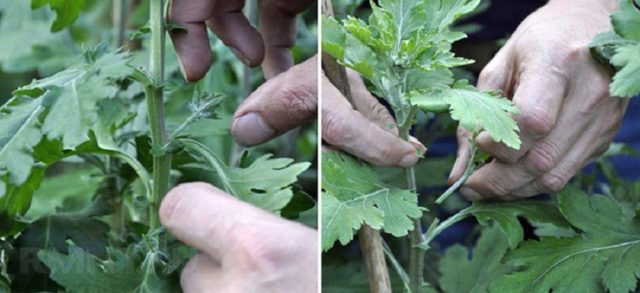
Timely pinching of the stem is the key to lush flowering
Preparing for winter
Large-flowered Baltic can freeze in winter. To preserve the bush, it must be dug up and transplanted into a container or pot together with a lump. Store at 0-5 ° C until spring. Humidity 80%. A basement or cellar is suitable. Care - sparse watering to prevent the coma from drying out. If the plant is planted in the south, you can cut off the shoots, huddle the bush well and cover it. However, it is better not to experiment with the Baltic and transfer the chrysanthemum to the basement for the winter. To land in the spring.
Diseases and pests
Compliance with the requirements of agricultural technology guarantees the absence of diseases and pests on the bushes. The main requirement is to avoid thickening of the chrysanthemum. Otherwise, fungal infections such as verticillium wilting, powdery mildew, rust, gray rot may appear.
It is necessary to carry out preventive spraying, and treat with copper-containing agents.
If affected by viral infections, the chrysanthemum should be destroyed.
The main pest in the Baltic is the nematode. Prevention - treatment of the bush with Phosphamide in early spring.
Aphids can be found on the underside of the leaves. Folk compositions or Aktara (Aktellik) will help.
Reproduction
You can multiply the Baltic:
- By cuttings. This method is also suitable for hybrid varieties. It retains parental characteristics. Chrysanthemum should be cut in the fall and planted in the spring.
- By dividing the bush. Select a healthy, powerful shrub, carefully dig up and divide. Transplant delenki to a new place. Can be divided in spring (end of April or May).
- Seeds. Sowing from early March to mid-April. Transplant the formed seedlings into the ground.
The latter option does not guarantee that all plant traits will be preserved. Especially when planting seeds collected with your own hands.
Conclusion
Chrysanthemum Baltika will decorate any site. Gardeners need to follow the growing rules and carefully observe the plants. This will allow you to grow powerful healthy bush chrysanthemums, both for cutting and for decorating compositions.

